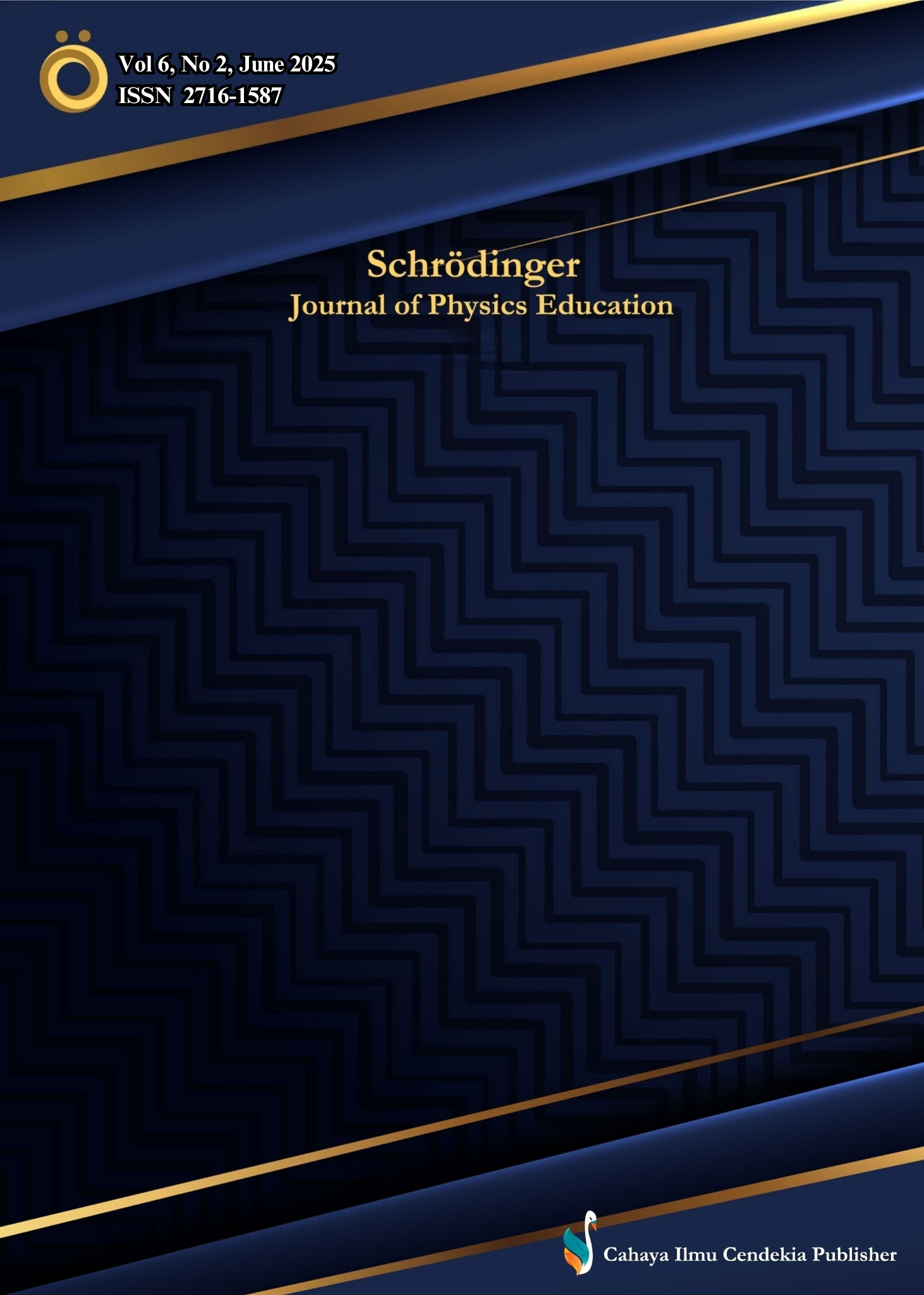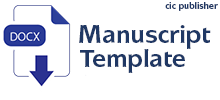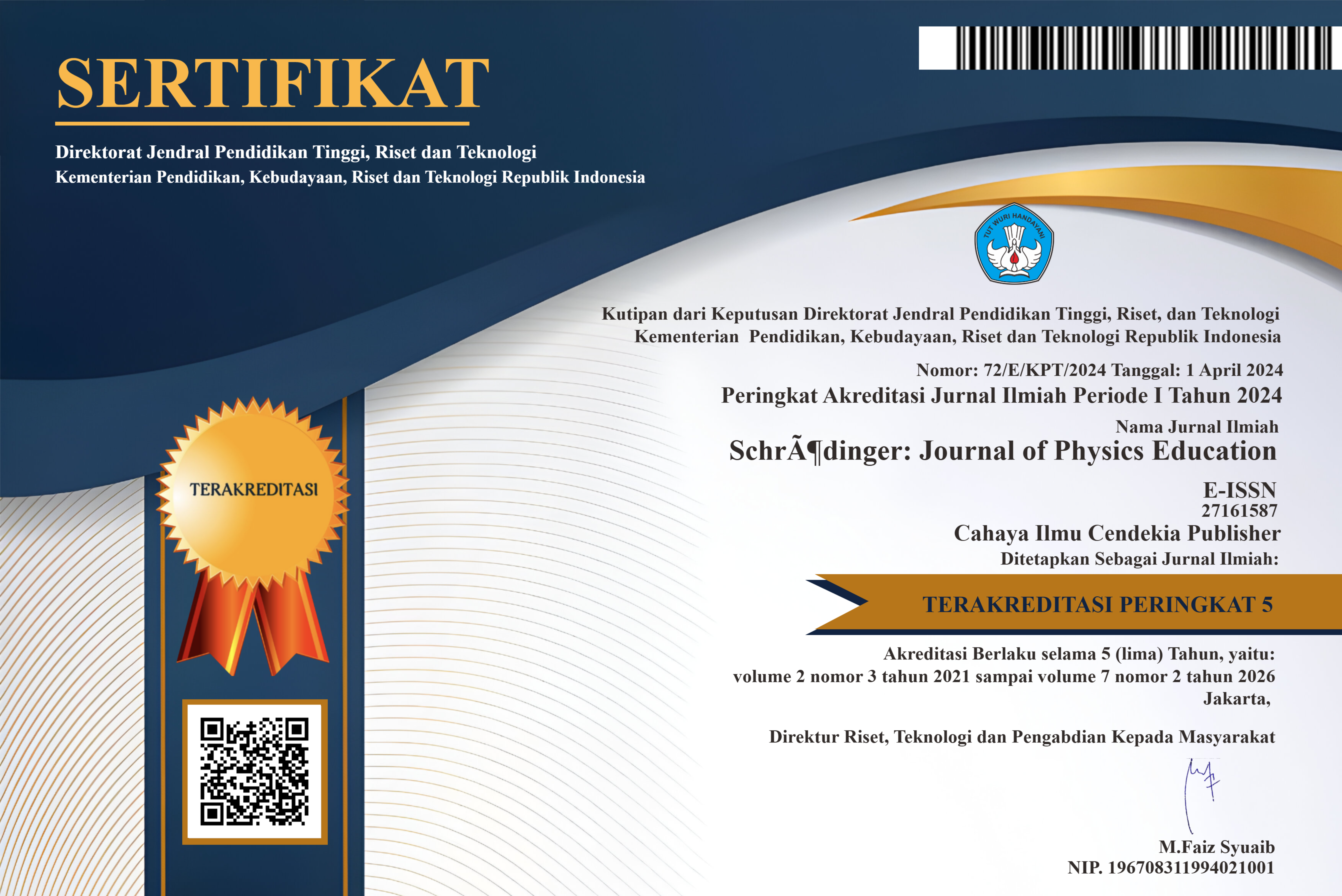Teachers' Perceptions of the Physics Learning Process Using the Direct Instruction Model in Junior High Schools
Abstract
Purpose of the study: This study aims to identify teachers' perceptions of the physics learning process using the direct instruction model at senior high school 1 Jeneponto.
Methodology: This research is a qualitative research that produces data presented in narrative form and describes what is from a variable, symptom or condition and does not intend to test the hypothesis. The data sources in this study were three physics teachers at senior high school 1 Jeneponto.
Main Findings: The results of the study showed that students and physics teachers of senior high school 1 Jeneponto have a positive perception of the Direct Instruction learning model. Teachers apply the Direct Instruction learning model according to the steps in the theory, while some teachers do not implement the steps of the direct instruction learning model in the practical section because there are no practical tools for class XII material, teachers have prepared the things needed in learning, teachers have the ability to teach according to the existing theory. By using this direct instruction learning model, students have been able to achieve several achievements and have played an active role in learning.
Novelty/Originality of this study: The novelty of this study lies in revealing physics teachers' contextual perceptions of the Direct Instruction model through a qualitative approach. Despite limited practical tools, teachers strive to follow the model, positively impacting student engagement and achievement. This offers a fresh perspective on its real-world implementation rarely explored in prior studies.
References
M. Suliani, “Persepsi Siswa Terhadap Penggunaan Alat Peraga dalam Pembelajaran Matematika [Students’ Perceptions of the Use of Teaching Aids in Mathematics Learning],” SJME (Supremum J. Math. Educ., vol. 4, no. 1, pp. 92–100, 2020, doi: 10.35706/sjme.v4i1.3143.
T. Noor, “Rumusan Tujuan Pendidikan Nasional Pasal 3 Undang-Undang Sistem Pendidikan Nasional No 20 Tahun 2013 Melalui Pendekatan Nilai-Nilai Yang Terkandung Dalam Ayat 30 Surah Ar-Ruum dan Ayat 172 Surah Al-‘Araaf [Formulation of National Education Goals Article 3,” Univ. Singaperbangsa Karawang, no. 20, pp. 123–144, 2018.
F. Berthalita Pujaningsih, J. Lestari Tambunan, I. Sakti, and T. Haryanto Wibowo, “Persepsi mahasiswa terhadap lembar kerja berbasis proyek pada materi struktur kristal [Student perceptions of project-based worksheets on crystal structure material],” J. Pendidik. Fis. dan Ter., vol. 5, no. 2, pp. 1–8, 2022, doi: 10.46918/karst.v5i2.1565.
D. W. S. Rahadiyani, P. A. Rivani, and F. Untari, “Implementation of problem based learning model as an effort to improve student activities and outcomes in temperature and heat materials,” Integr. Sci. Educ. J., vol. 4, no. 1, pp. 19–22, 2023, doi: 10.37251/isej.v4i1.292.
R. Lee, K. Hoe Looi, M. Faulkner, and L. Neale, “The moderating influence of environment factors in an extended community of inquiry model of e-learning,” Asia Pacific J. Educ., vol. 41, no. 1, pp. 1–15, 2021, doi: 10.1080/02188791.2020.1758032.
A. M. Alzoebi, M. A. Ghunaimat, and E. A. Alawneh, “The effects of flipped classroom strategy based on ‘ADDIE model’ for algebraic skill development,” Anatol. J. Educ., vol. 8, no. 1, pp. 141–158, 2023, doi: 10.29333/aje.2023.8110a.
H. Sofyan, E. Anggereini, and J. Saadiah, “Development of e-modules based on local wisdom in central learning,” Eur. J. Educ. Res., vol. 8, no. 4, pp. 1137–1143, 2019, doi: 10.12973/eu-jer.8.4.1137.
S. Lestari, S. Mursali, and I. Royani, “Pengaruh model pembelajaran langsung berbasis praktikum terhadap keterampilan proses sains dan kemampuan berpikir kritis siswa [The influence of the direct learning model based on practical work on students’ science process skills and critical thinking ab,” J. Ilm. Biol., vol. 6, no. 1, pp. 67–79, 2018, doi: 10.33394/bioscientist.v6i1.2367.
S. W. Octavia, N. Septiani, F. Sinaga, and N. N. Qoidah, “Analysis of the relationship in learning interest to learning outcomes static fluid material in senior high school,” J. Ilm. Ilmu Terap. Univ. Jambi, vol. 87, no. 1,2, pp. 149–200, 2023, doi: 10.22437/jiituj.v7i1.26696.
Astalini, Darmaji, D. A. Kurniawan, S. W. Oktavia, E. Triani, and M. Z. Azzahra, “The exploration of character values in physics learning on momentum, impulse, and collision materials,” J. Educ. Res. Eval., vol. 7, no. 2, pp. 277–284, 2023, doi: 10.23887/jere.v7i2.52381.
E. Kuswanto, “Peranan guru PAI dalam pendidikan akhlak di sekolah [The role of Islamic religious education teachers in moral education in schools],” MUDARRISA J. Islam. Educ., vol. 6, no. 2, p. 194, 2015, doi: 10.18326/mdr.v6i2.194-220.
M. D. W. Ernawati, Sudarmin, Asrial, D. Muhammad, and Haryanto, “Creative thinking of chemistry and chemistry education students in biochemistry learning through problem based learing with scaffolding strategy,” J. Pendidik. IPA Indones., vol. 11, no. 2, pp. 282–295, 2022, doi: 10.15294/jpii.v11i2.33842.
A. Astalini et al., “Identification of student character values in class X particle dynamics materials,” JIPF (Jurnal Ilmu Pendidik. Fis., vol. 8, no. 3, pp. 380–388, 2023, doi: 10.26737/jipf.v8i3.3776.
T. Carmi and E. Tamir, “An emerging taxonomy explaining mentor-teachers’ role in student-teachers’ practicum: What they do and to what end?,” Teach. Teach. Educ., vol. 128, p. 104121, 2023, doi: https://doi.org/10.1016/j.tate.2023.104121.
L. M. Hodgson and K. J. Wilkie, “Modelling lessons for more than imitation: investigating teachers’ reactions and decompositions of unfamiliar practices,” J. Math. Teach. Educ., vol. 25, no. 6, pp. 749–775, 2022, doi: 10.1007/s10857-021-09516-1.
R. Frei-Landau, L. Orland-Barak, and Y. Muchnick-Rozonov, “What’s in it for the observer? Mimetic aspects of learning through observation in simulation-based learning in teacher education,” Teach. Teach. Educ., vol. 113, p. 103682, 2022, doi: https://doi.org/10.1016/j.tate.2022.103682.
M. Chu, “A preliminary study of model-generated speech,” Appl. Sci., vol. 14, no. 3104, pp. 1–20, 2024, doi: 10.3390/ app14073104.
M. G. Fiorentino and A. Montone, “Learning the Mathematical Discussion ( MD ) Pedagogical Model in and from Practice : The Professional Development of Mathematics Teachers in a Technological Environment,” no. Md, 2025.
G. M. Tinungki et al., “Exploring the team-assisted individualization cooperative learning to enhance mathematical problem solving, communication and self-proficiency in teaching non-parametric statistics,” Cogent Educ., vol. 11, no. 1, pp. 1–27, 2024, doi: 10.1080/2331186X.2024.2381333.
Endang Indarini, “Dampak Model Problem Based Learning Terhadap Keterampilan Abad 21 (4 C) di Sekolah Dasar,” Satya Widya, vol. 40, no. 1, pp. 73–87, 2024, doi: 10.24246/j.sw.2024.v40.i1.p73-87.
T. Aytaç and S. S. Kula, “The Effect of Student-Centered Approaches on Students’ Creative Thinking Skills: A Meta-Analysis Study.,” Int. J. Contemp. Educ. Res., vol. 7, no. 2, pp. 62–80, 2020.
M. S. Sarumaha and R. E. Laiya, “Teachers ’ Ability to Construct Learning Through the Scramble Learning Model Approach in Schools,” Tafkir Interdiscip. J. Islam. Educ., vol. 4, no. 4, pp. 577–589, 2023.
H. M. Asim, A. Vaz, A. Ahmed, and S. Sadiq, “A review on outcome based education and factors that impact student learning outcomes in tertiary education system,” Int. Educ. Stud., vol. 14, no. 2, p. 1, 2021, doi: 10.5539/ies.v14n2p1.
A. Hidayatulloh, “Analisis Kesulitan Belajar Fisika Materi Elastisitas Dan Hukum Hooke Dalam Penyelesaian Soal – Soal Fisika,” Kappa J., vol. 4, no. 1, pp. 69–75, 2020, doi: 10.29408/kpj.v4i1.1636.
Nadirah, A. D. R. Pramana, and N. Zari, “METODOLOGI PENELITIAN Kualitatif, Kuantitatif, Mix Method (Mengelola,” 2022.
S. W. Oktavia, H. Mansur, and M.Hidayat, “Investigasi Keterampilan Mengajar Guru Fisika di SMA N 9 Kerinci,” J. Relativ., vol. 6, no. 1, pp. 24–30, 2023.
J. Jalwis and N. Habibi, “Konstruk Pendidikan Multikultural (Studi Urgensi Integrasi Nilai-nilai Multikultural dalam Kurikulum Pendidikan),” Tarbawi J. Ilmu Pendidik., vol. 15, no. 2, pp. 233–247, 2019, doi: 10.32939/tarbawi.v15i02.453.
E. F. S. Rini and F. T. Aldila, “Practicum activity: analysis of science process skills and students’ critical thinking skills,” Integr. Sci. Educ. J., vol. 4, no. 2, pp. 54–61, 2023, doi: 10.37251/isej.v4i2.322.
C. Andrade, “The Inconvenient Truth About Convenience and Purposive Samples,” Indian J. Psychol. Med., vol. 43, no. 1, pp. 86–88, 2021, doi: 10.1177/0253717620977000.
A. Abbas and M. Yusuf Hidayat, “Faktor-Faktor Kesulitan Belajar Fisika Pada Peserta Didik Kelas IPA Sekolah Menengah Atas,” JPF (Jurnal Pendidik. Fis. Univ. Islam Negeri Alauddin Makassar, 2018, doi: 10.24252/jpf.v6i1a8.
S. Saharuddin and M. Wahab, “Analisis Kesulitan Dalam Pemebelajaran Ipa Di Smp Negeri Limboro,” J. IPA Terpadu, vol. 2, no. 2, pp. 75–83, 2019, doi: 10.35580/ipaterpadu.v2i2.11148.
A. Baltacı, “Nitel Veri Analizinde Miles-Huberman Modeli,” Ahi Evran Üniversitesi Sos. Bilim. Enstitüsü Derg., vol. 3, no. 1, pp. 1–15, 2017.
S. Ahn, M. Choi, J. Lee, J. Kim, and S. Chung, “Non-Contact Fall Detection System Using 4D Imaging Radar for Elderly Safety Based on a CNN Model,” pp. 1–21, 2025.
R. Hiyasat and L. Luyten, “Integrating Virtual Reality to Enhance Thermal Comfort in Educational Spaces : A Pilot Study Towards Sustainable Learning Environments,” pp. 1–28, 2025.
I. Kliziene, G. Cizauskas, S. Sipaviciene, R. Aleksandraviciene, and K. Zaicenkoviene, “Effects of a physical education program on physical activity and emotional well-being among primary school children,” Int. J. Environ. Res. Public Health, vol. 18, no. 14, 2021, doi: 10.3390/ijerph18147536.
J. G. Djokoto, P. Pomeyie, and C. A. Wongnaa, “Foreign direct investment in food manufacturing and stages of human development,” Cogent Econ. Financ., vol. 11, no. 2, 2023, doi: 10.1080/23322039.2023.2267738.
Y. Liu, Q. Wei, W. Wang, L. Zhao, and N. Hu, “Multiscale modeling and data-driven life prediction of kinematic interface behaviors in mechanical drive systems,” Coatings, vol. 15, no. 6, pp. 1–33, 2025, doi: 10.3390/coatings15060660.
E. Hasanah, A. Destya, I. Kusumawati, and A. Limba, “The Mediating Role of Student Independence on Graduate Quality in Distributed Learning Enung,” Int. J. Instr., vol. 15, no. 1, pp. 61–82, 2022, doi: 10.4135/9781483318332.n114.
A. Nigam, R. Pasricha, T. Singh, and P. Churi, “A systematic review on ai-based proctoring systems: past, present and future,” Educ. Inf. Technol., vol. 26, no. 5, pp. 6421–6445, 2021, doi: 10.1007/s10639-021-10597-x.
R. Bellová, D. Melicherčíková, and P. Tomčík, “Possible reasons for low scientific literacy of Slovak students in some natural science subjects,” Res. Sci. Technol. Educ., pp. 1–18, 2017, doi: 10.1080/02635143.2017.1367656.
H. T. Thuy and H. D. Thuy-Ha, “STEM education in non-formal learning institutions in ethnic monority and mountainous areas: A look from Ha Giang city’s community learning centre,” J. Phys. Conf. Ser., vol. 1340, no. 1, 2019, doi: 10.1088/1742-6596/1340/1/012033.
E. W. Simamora, “The effect of student team achievement division cooperative learning on the concept understanding ability of mathematic,” Adv. Soc. Sci. Educ. Humanit. Res., vol. 104, no. 22, pp. 407–411, 2017, doi: 10.2991/aisteel-17.2017.87.
E. Yanti, D. Hermon, E. Barlian, I. Dewata, and I. Umar, “Directions for sanitation-based environmental structuring using ahp for the prevention of diarrhea in Pagar Alam city - Indonesia,” Int. J. Manag. Humanit., vol. 4, no. 9, pp. 25–29, 2020, doi: 10.35940/ijmh.i0848.054920.
Copyright (c) 2025 Resky Yani, Ismail Ismail, Sing Huat Poh

This work is licensed under a Creative Commons Attribution 4.0 International License.
Authors who publish with this journal agree to the following terms:
- Authors retain copyright and acknowledge that the Schrödinger: Journal of Physics Education is the first publisher licensed under a Creative Commons Attribution 4.0 International License.
- Authors are able to enter into separate, additional contractual arrangements for the non-exclusive distribution of the journal's published version of the work (e.g., post it to an institutional repository or publish it in a book), with an acknowledgment of its initial publication in this journal.
- Authors are permitted and encouraged to post their work online (e.g., in institutional repositories or on their website) prior to and during the submission process, as it can lead to productive exchanges and earlier and greater citation of published work.







.png)
.png)








.png)
.png)
.png)







